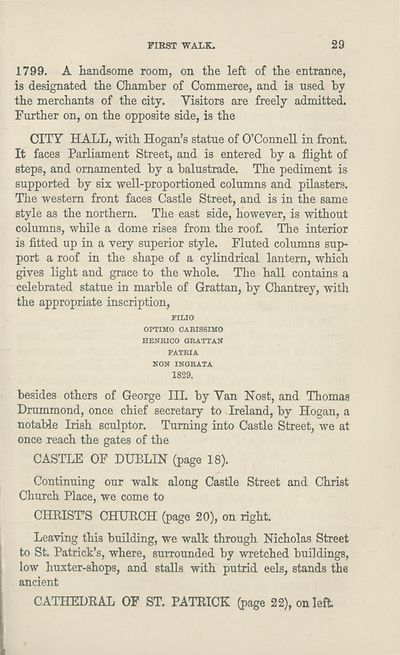Download files
Complete book:
Individual page:
Thumbnail gallery: Grid view | List view

FIRST WALK.
1799. A handsome room, on the left of the entrance,
is designated the Chamber of Commerce, and is used by
the merchants of the city. Visitors are freely admitted.
Further on, on the opposite side, is the
CITY HALL, with Hogan’s statue of O’Connell in front.
It faces Parliament Street, and is entered by a flight of
steps, and ornamented by a balustrade. The pediment is
supported by six well-proportioned columns and pilasters.
The western front faces Castle Street, and is in the same
style as the northern. The east side, however, is without
columns, while a dome rises from the roof. The interior
is fitted up in a very superior style. Fluted columns sup¬
port a roof in the shape of a cylindrical lantern, which
gives light and grace to the whole. The hall contains a
celebrated statue in marble of Grattan, by Chantrey, with
the appropriate inscription,
OPTIMO CARISSIMO
HENRICO GRATTAN
NON INGRATA
1829.
besides others of George III. by Van Host, and Thomas
Drummond, once chief secretary to Ireland, by Hogan, a
notable Irish sculptor. Turning into Castle Street, we at
once reach the gates of the
CASTLE OF DUBLIN (page 18).
Continuing our walk along Castle Street and Christ
Church Place, we come to
CHRISTS CHURCH (page 20), on right.
Leaving this building, we walk through Nicholas Street
to St. Patrick’s, where, surrounded by wretched buildings,
low huxter-shops, and stalls with putrid eels, stands the
ancient
CATHEDRAL OF ST. PATRICK (page 22), on left
1799. A handsome room, on the left of the entrance,
is designated the Chamber of Commerce, and is used by
the merchants of the city. Visitors are freely admitted.
Further on, on the opposite side, is the
CITY HALL, with Hogan’s statue of O’Connell in front.
It faces Parliament Street, and is entered by a flight of
steps, and ornamented by a balustrade. The pediment is
supported by six well-proportioned columns and pilasters.
The western front faces Castle Street, and is in the same
style as the northern. The east side, however, is without
columns, while a dome rises from the roof. The interior
is fitted up in a very superior style. Fluted columns sup¬
port a roof in the shape of a cylindrical lantern, which
gives light and grace to the whole. The hall contains a
celebrated statue in marble of Grattan, by Chantrey, with
the appropriate inscription,
OPTIMO CARISSIMO
HENRICO GRATTAN
NON INGRATA
1829.
besides others of George III. by Van Host, and Thomas
Drummond, once chief secretary to Ireland, by Hogan, a
notable Irish sculptor. Turning into Castle Street, we at
once reach the gates of the
CASTLE OF DUBLIN (page 18).
Continuing our walk along Castle Street and Christ
Church Place, we come to
CHRISTS CHURCH (page 20), on right.
Leaving this building, we walk through Nicholas Street
to St. Patrick’s, where, surrounded by wretched buildings,
low huxter-shops, and stalls with putrid eels, stands the
ancient
CATHEDRAL OF ST. PATRICK (page 22), on left
Set display mode to:
![]() Universal Viewer |
Universal Viewer | ![]() Mirador |
Large image | Transcription
Mirador |
Large image | Transcription
| Antiquarian books of Scotland > Ireland/Irish > Black's guide to Dublin and the Wicklow mountains > (31) |
|---|
| Permanent URL | https://digital.nls.uk/114416518 |
|---|
| Description | Thousands of printed books from the Antiquarian Books of Scotland collection which dates from 1641 to the 1980s. The collection consists of 14,800 books which were published in Scotland or have a Scottish connection, e.g. through the author, printer or owner. Subjects covered include sport, education, diseases, adventure, occupations, Jacobites, politics and religion. Among the 29 languages represented are English, Gaelic, Italian, French, Russian and Swedish. |
|---|

